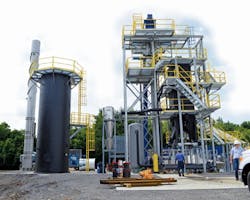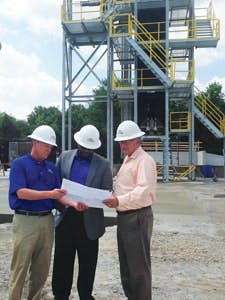About the author: Mike Webb is vice president of marketing for PHG Energy in Nashville. Webb can be reached at [email protected] or 615.471.9299.
The waste-to-energy gasifier under construction in Lebanon, Tenn.
The city of Lebanon, Tenn., (population: 30,000) wanted to find a path forward to becoming more sustainable and environmentally conscious in its overall waste disposal methods and reduce its dependence on commercial landfills as a primary option. Keeping the solutions financially self-sustaining was a mandatory part of the project.
The city’s initial meetings with PHG Energy in nearby Nashville led it to consider and implement the first stage of an overall waste-to-energy strategy: Combine municipal sewer sludge, wood waste from local industries and scrap tires from Wilson County, Tenn., into a biomass feedstock for gasification, and convert the resulting syngas to electrical power utilizing Organic Rankine Cycle (ORC) generators.
“We talked with a dozen companies over the past few years about technologies that could help us handle our waste streams in an environmentally friendly manner,” said Lebanon Mayor Philip Craighead.
The new plant is slated for completion in October 2016 and will provide nearly 200 kW of clean power for the wastewater treatment plant (half the total load) while diverting at least 32 tons per day of waste material away from local landfills. The city’s plan is to implement a full material recovery facility (MRF) in coming years and deploy gasification of refuse derived fuel (RDF) pellets and steam turbine generation capacity in the process, thus taking control of all its waste streams.
Evann Freeman (center), field representative for Sen. Lamar Alexander, and Mayor Philip Craighead (right), stopped by the construction site to be briefed on the municipal waste-to-energy project.
A Partnership to Solve a Problem
Forming a public-private partnership with local industries was key to making the system financially attractive, according to PHGE Spokesman and Chief Operating Officer Chris Koczaja: “Local companies were paying to have wood waste hauled to landfills. We developed a process whereby they paid tipping fees to the city to take the wood, lowering their costs and providing excellent feedstock for our downdraft gasification plant,” he said.
Wilson County decided that the several hundred tons of scrap tires it was paying to have hauled away each year also could be sent to the gasification blend at considerable savings.
The $3.5 million gasification plant is located on the site of the city wastewater treatment facility, and the power produced is utilized “behind the meter” to offset power previously purchased from the local utility. As an added financial bonus, the treatment plant was able to retire a very power-hungry digester unit since the sludge is being sent directly to the gasification unit.
Design Objectives
The overall objective of the plant is multi-fold. The energy created will provide clean, sustainable power for the wastewater treatment plant while eliminating the hauling and spreading costs of sewer sludge. It also will reduce the amount of municipal material hauled to landfills and tipping fees paid. The addition of scrap tires to the feedstock brings a beneficial use to an old problem. This new system will be financially viable and not a burden to taxpayers as it was when tipping fees were paid to commercial partners, and it will create a new infrastructure for future expansion.
Assessing the System
The overall footprint of the gasification plant is less than one acre. In that space, the unit has a 64-ton-per-day capacity. Through the core technology of the PHG Energy downdraft gasifier, the syngas produced (92% by volume input) is combusted in an industrial thermal oxidizer (an emissions control device). That thermal energy is transferred to heat oil fluid, and the hot oil drives a 400-kW ORC generator.
All feedstock is locally sourced and prepped by a specialty contractor. This company will ensure that wood and tires are cut to 1- to 3-in. size. Sludge will be blended with that mixture on site.
The target moisture content of the total blend is 30%. The blend will yield 8% biochar that is 70% carbon and recyclable. Commissioning of the plant will take place in October of 2016.
The Benefits to Come
When the plant is running at full capacity, 5 million lb (2,500 tons) of carbon emissions will be kept out of the air each year, which equates to the CO2 produced annually to provide electricity to 312 homes, or the annual Greenhouse Gas Emissions from more than 450 passenger vehicles. More than 16 million lb (8,000 tons) of material will be diverted from landfills each year, and this will help both the city and local industries move toward zero landfill goals. The system will create a positive use for more than 800,000 lb (400 tons) of scrap tires annually. In addition, more than 20 million kWh of renewable electricity during the 20-year lifespan of the project will be produced.

